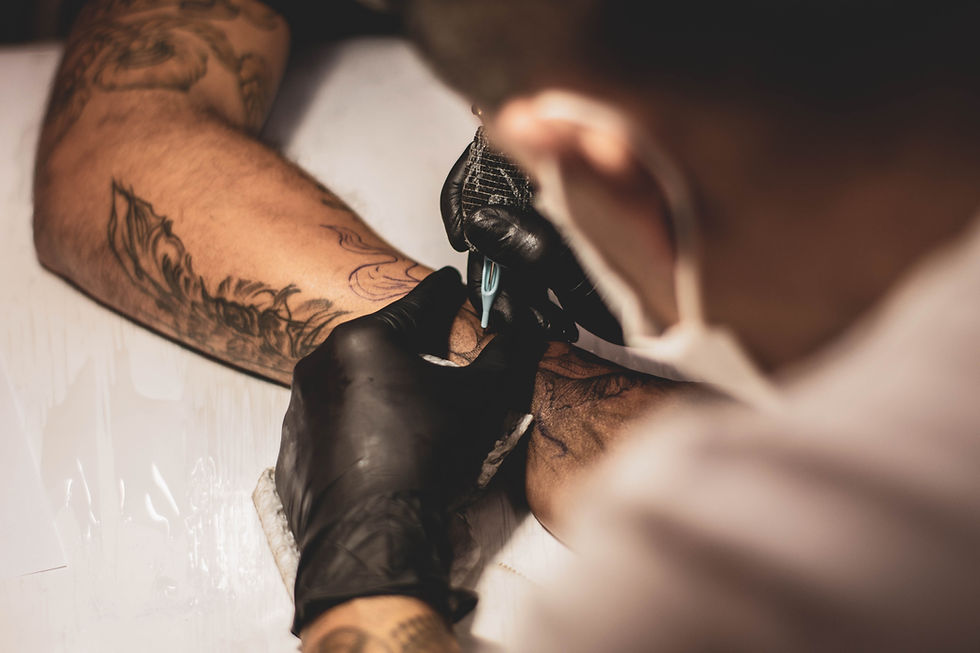Are Tattoos Copyrighted?
- Owning It
- Nov 14, 2021
- 4 min read
Updated: Dec 17, 2021

Image courtesy of Lucas Lenzi via the Unsplash Licence. Available at: https://unsplash.com/photos/zeT_i6av9rU
In general, if you create an original design for a tattoo, you own the copyright of that tattoo.
You should always retain archives of images of your tattoos and the date that they were created, through digital photographs or some other record-keeping method.
Your client can show off their tattoo, but they are obliged to credit you as the artist where appropriate.
Introduction
“My body is my journal, and my tattoos are my story.” ― Johnny Depp
According to a report by the CNN, the oldest existing example of tattoo art on the planet was a pencil moustache tattooed onto the upper lip of a young Peruvian.
Today's tattoos have clearly moved beyond that pencil moustache to encompass original designs, cultural symbols or even a brand’s trade mark.[1] Taking our cue from Johnny Depp, there is no doubt that a tattoo can tell a captivating story.
Many people understand that owning a print or a painting does not mean you own the copyright of that image. But tattoos are obviously more connected (literally) to the person than say a painting on the wall. So does that connection to your body mean that you own it? How does copyright law fit into the picture?
The answer might surprise clients and, at the same time, empower tattoo artists.
How does copyright law treat tattoos?
"Of course tattoos can be copyrighted. I don't think that there is any reasonable dispute about that."
- Judge Catherine D Perry in a 2011 Federal Court hearing involving Mike Tyson's facial tattoo.
From a legal standpoint, the fact that an original artistic work has been applied to skin rather than canvas or other surface makes no difference.
The work of a tattoo artist can be treated like any other artistic work and may be capable of copyright protection should the threshold requirements of the law be met.
To date, there have been no reports of court cases in Australia directly addressing the issue of copyright protection in tattoos, so the law in this area has yet to be explored. However, disputes that have arisen over tattoos overseas may shed some light and provide useful guidance on what could happen in Australia.
Who owns a tattoo?
The answer of who owns a tattoo design comes down to the question of who owns copyright, and how copyright law works.
In Australia, the rules of copyright are enshrined in a piece of law called the Copyright Act. This law basically says that a tattoo artist is the owner of their tattoo design so long as it is original and reduced to material form.
‘Original’ refers to a work that is not copied from another work. ‘Material form’ means that the work needs to be actually drawn in a look book or tattooed onto skin.[2] A mere idea of a tattoo (e.g. a bird with a blue beak) is just that – an idea – and unless and until it is given some form of expression, copyright protection will not apply.
Now that we know what is protected under copyright law, let’s talk about ownership.
Even, if someone has an idea for a design, it is the person who puts the “pen to paper”, or the “tattoo machine to skin” that actually owns the copyright. . This is because copyright law protects the expression of ideas, not the ideas themselves.
Similarly, if you create an original design, just because a client has paid for it to be tattooed on their body, this won’t mean that they own copyright. The copyright generally stays with you (unless you specifically agree otherwise).
This means that many people can walk out of the tattoo parlour with the same arrow design and the tattoo artist is in the clear.
Most tattoo artists would understand this as it makes sense if they have created the design.
What does owning copyright actually mean?
Basically, copyright law gives people a right to make money out of their original work and control its use.
While anyone can display their tattoo proudly, or be photographed with it in the ordinary course of their day-to-day lives, this will not mean that they own copyright it in the image itself or not be obliged to credit you as the artist (where appropriate).
Australia has yet to see any tattoo artists running into the Courts, but there have been several instances in the United States where tattoo artists have claimed copyright infringement of their work. Notable examples include:
Mike Tyson’s face tattoo
In 2011, tattoo artist S. Victor Whitmill had a dispute with Warner Brothers for copyright infringement over the movie The Hangover Part II, which featured a replica of Mike Tyson’s face tattoo on one of the lead actors’ faces.
Using a lion tattoo in a video game
In 2012, tattooist Christopher Escobedo demanded compensation from the video game maker, THQ Inc.. They used a lion tattoo he had designed for a martial artist named Carolos Condit whose character was featured in THQ Inc.s’ UFC Undisputed video game.
Characters featured in a video game with their tattoos
In 2016, Solid Oak LLC filed a suit against video game company 2K, game publisher Take Two, and game developer Visual. They complained that the video game NBA 2K16 copied the likeness of basketball players LeBron James, Kobe Bryant, Eric Bledsoe, DeAndre Jordan, and Kenyon Martin, including their tattoos that they just happened to have.
The tattoo artists who had created those tattoos had signed licensing agreements with Solid Oaks Sketches, LLC.
What can we learn?
Just because a tattoo (with an original design) is permanently fixed onto a person’s skin, doesn’t mean that it can be reproduced for commercial purposes. True that people own their body but they will not necessarily own copyright in someone else’s image.



Comments